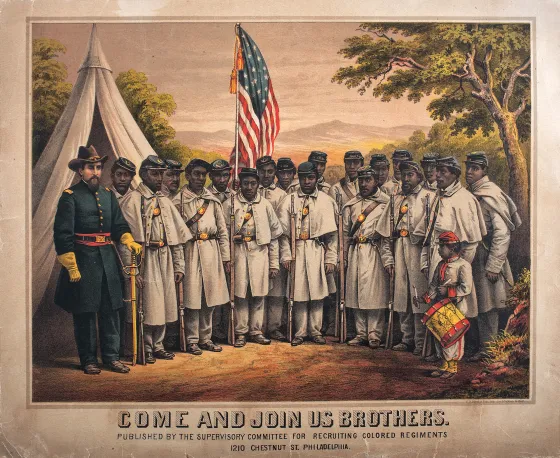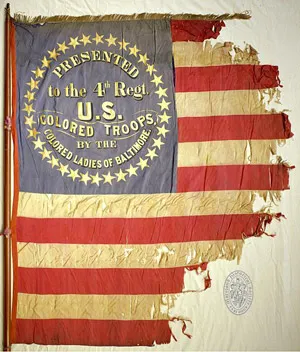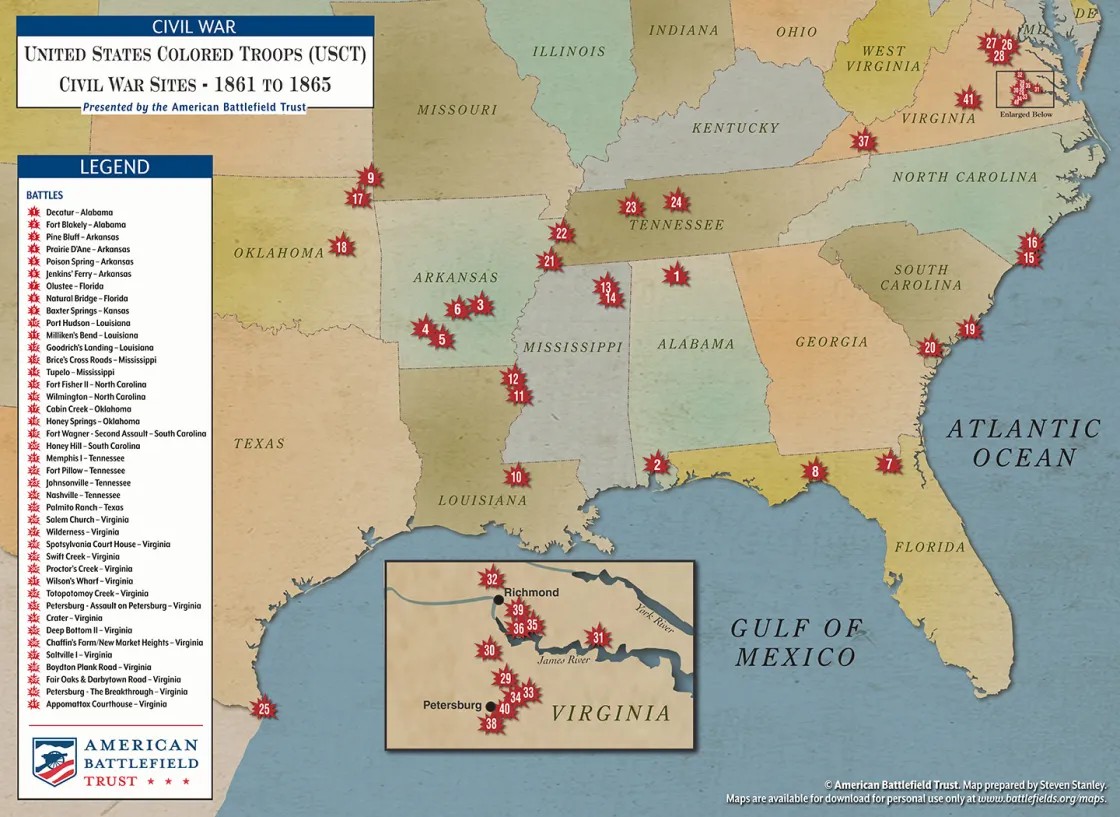
On May 17, 2014, the State of Virginia and Spotsylvania County Tourism unveiled a state marker dedicated to the 23rd Colored Infantry to commemorate their first skirmish against the Army of Northern Virginia. This dedication occurred during the 150th anniversary program of this skirmish – the first directed combat between African American soldiers and General Robert E. Lee’s army.

The story of the 23rd United States Colored Troops (USCT), otherwise known as the 23rdUnited States Colored Infantry (USCI) began in Fredericksburg, Virginia, which was then a small city in Spotsylvania County. On Good Friday, April 18, 1862, the Union army first occupied the city. From April until the end of August 1862, over 10,000 enslaved people escaped from the various counties around Fredericksburg and went under the protection of the Union army. Many of them began to work for the Union soldiers in support occupations. Some of the black men became scouts for the army. When the Union army went north on the first couple of days in September, they became contrabands around the city of Washington, DC. At this time, these men were not allowed to be soldiers in the Union army. However, that would change in November 1863, when some of them became soldiers in the 23rd USCT.
The men of the 23rd were recruited in Washington, D.C. They were organized from November 23, 1863 through June 30, 1864, and trained at Camp Casey, Virginia. Some soldiers were in camp as late as July 8th. Camp Casey was located near the area where the Pentagon is today. Many were free men and ex-slaves from Virginia, Stafford, Spotsylvania, Orange, Culpeper, and Caroline counties and the city of Fredericksburg.
In January 1864, General Ambrose E. Burnside was asked to reorganize the IX Corps. He asked for and was granted permission, by Secretary of War Edwin Stanton, to form a division of “colored troops.” The 4th Division of the IX Corps infantry would be all black troops, commanded by General Edward Ferrero.
The regiments were divided into two brigades; the first brigade was made up by the 27th, 30th, 39th, and 43rd USCT. The second brigade was the 30th Connecticut Colored Infantry (only 4 companies formed then consolidated into 31st USCT), 19th, 23rd, 31st USCT. In late June, the 28th and 29th USCT regiments were added to the second brigade. These regiments came from all across the North, from Illinois to Connecticut and the east from New York to Virginia.
When the 4th Division of the IX Corps left Camp Stanton in Annapolis Maryland, they were paraded in front of President Abraham Lincoln and General Burnside in Washington, DC. The 23rd joined the division when the men marched across the bridge into Virginia. The IX Corps was an independent army corps at that time because General Burnside outranked General George Gordon Meade, the commander of the Army of the Potomac. The IX corps assisted the Army of the Potomac, however, this created an awkward command structure for General in Chief Ulysses S. Grant. He had to issue two sets of commands, as he wanted both armies working together. The coordination between the two commanders was difficult in the opening battles of the Overland Campaign. On May 24, 1864, General Grant ordered the IX Corps to become part of the Army of the Potomac, just before the Battle of the North Anna River.
On May 5th, General Ferrero wanted to rest his men, since they had marched over 30 miles within 24 hours. However, as soon as General Burnside heard about the fighting in the Wilderness, the 4th Division was told to move immediately. By May 6th they had crossed Germanna Ford and were ordered to report to General John Sedgwick of the VI Corps. Two regiments were ordered to guard the ford and the rest were deployed to the right of the VI Corps. After the VI corps was broken by General John B. Gordon’s flank attack, the 4thDivision was ordered to the sound of the battle, but the shooting stopped before they arrived. They did not fight in this battle. They were ordered to the Plank Road – where they guarded the wagon trains.

From May 7th until the end of the battle of Spotsylvania Court House, the 4th Division guarded and escorted wagon trains behind the lines and to the Belle Plains depot.
The 23rd USCT became the first colored troops to fight in “directed combat” against Confederate General Robert E. Lee’s Army of Northern Virginia. The skirmish was fought at the intersection of Catharpin and Old Plank Roads (originally Orange Plank Road) on May 15, 1864. The 23rd was at the Chancellorsville ruins, when the Union 2nd Ohio Cavalry was chased by General Thomas Rosser’s Confederate Cavalry Brigade. The 2nd asked for assistance and the only soldiers nearby were General Edward Ferrero’s colored division. The 23rd USCT “double quicked” the two miles to the intersection and drove back Rosser’s cavalry, as ordered by General Ferrero. The black soldiers were cheered by the 2nd Ohio, who now gave chase to Rosser’s cavalry. This battle action proved to the white troops that black soldiers would fight against the Confederate army.
General Ferrero reported the action to General Grant. Below is the order from the Official Records of the War of the Rebellion, (Chapter XLVIII page 986; Operations in SE, VA. and N. C.):
“HDQRS. FOURTH DIVISION NINTH ARMY CORPS,
Miller’s House, on Plank road east of Alrich’s, May 15, 1864.
GENERAL: I have the honor to report that at 12.30 p. m. this day the Second Ohio Cavalry, stationed at Piney Branch Church, were compelled to fall back, being attacked by superior forces, consisting of one brigade of cavalry, with two pieces of artillery. I immediately ordered the Fourth Division in readiness, and marched the Twenty-third U. S. Colored Troops to support the cavalry. On arriving at Alrich’s, on the Plank road, I found the Second Ohio driven across the road, and the enemy occupying the cross-roads. I ordered the colored regiment to advance on the enemy in line of battle, which they did, and drove the enemy in perfect rout. Not being able to pursue with infantry, the Second Ohio formed and gave chase to Piney Branch Church, which they (the Second Ohio) now occupy. All quiet elsewhere. Our loss amounted to 8 or 10 wounded. The enemy lost some 5 horses killed. I have changed my position to a more secure one, to protect the trains and roads leading to the army. I have since learned from one of my scouts that Hampton’s brigade is in full retreat, in perfect disorder, toward Todd’s Tavern.
I am, general, very respectfully, your obedient servant,
EDW. FERRERO
Brigadier-General, Commanding.
Brigadier-General RAWLINS,
Chief of Staff.”
The most famous battle in which the 23rd USCT fought was the Battle of the Crater, during the siege of Petersburg. In July, a regiment of miners in the IX Corps built a mine under the Confederate fort opposing their position. It was loaded with tons of explosives. On July 30, 1864, the 4th Division of the IX Corps had been trained for the attack on the Confederate line. However, due to a last minute change by General Meade, the black soldiers were the last to enter the battle, instead of the first. The three white divisions of the IX Corps, did not follow General Burnside’s plan and delayed the attack. By the time the colored troops entered the battle, the Confederates were ready to counterattack. Before being driven into the Crater, the black troops advanced further than the white troops. The Confederate counterattack was a furious attack that won the day for the Confederate army. The black troops sustained the worst casualties of which the 23rd suffered the most.

After the Battle of the Crater, the IX Corps is reduced to 3 divisions and the black division became the 3rd Division of the IX Corps. In December 1864, it joined with the black divisions of the X and XVIII Corps of the Army of the James, to become the XXV Corps. The XXV Corps was an all-black corps in the Army of the James and the largest grouping of black soldiers in the Civil War. They would fight in Richmond and Petersburg, while some of the regiments would fight at the Battles of Fort Fisher and Wilmington, N. C. The XXV Corps will be divided with some in Richmond, Petersburg, and Appomattox. On April 7, 1865, the 23rd USCT was sent back into Petersburg. In May through November 1865, they served in Texas with General Philip Sheridan’s army of 50,000 troops. The 23rd USCT would be mustered out of service on November 30, 1865. Their service record appears below.
Service – The 23rd served in the following battles and campaigns:
· Overland Campaign, May to June 1864 (May 15th Battle of Spotsylvania Court House skirmish with General Rosser’s Cavalry)
· Battle of Petersburg, June 15 – 18, 1864
· Siege of Petersburg and Richmond, June 1864 – April 2, 1865
- Battle of the Crater - July 30, 1864
- Weldon Railroad - August 18-21, 1864
- Fort Sedgwick – September 28, 1864
- Poplar Grove Church – September 29-30, 1864
- Boydton Plank Road, Hatcher’s Run – October 27-28, 1864
- Bermuda Hundred – December 13, 1864
- Bermuda Hundred Front – December 1864 – March 1865
· Appomattox Campaign, March 28th to April 9th, 1865
- Hatcher’s Run – March 29-31, 1865
- Fall of Petersburg - April 2, 1865
- Pursuit of Lee – April 3 – 9, 1865
- Surrender of Army of Northern Virginia – April 9, 1865
· Duty in Department of Virginia until May 1865
· Department of Texas from May until November 1865
· Mustered out November 30, 1865.
Although there are many other black regiments that fought in more famous battles than the 23rd USCT, they were the first to fight in directed combat against the most famous Confederate army in the Civil War. In fact, between May 15th and 24th, 1864, there would be two skirmishes and one battle between USCT and the Army of Northern Virginia. After the May 15th skirmish, the entire 4th Division of the IX Corps would skirmish with General Rosser’s Confederate cavalry on May 19th during the Battle of Spotsylvania Court House, encompassing a much larger area than the first skirmish. On May 24th, the 1st and 10th USCT, the Army of the James, with the assistance of some white soldiers and a Union gunboat, defeated General Fitz Lee’s Confederate cavalry at the Battle of Wilson’s Wharf or Fort Pocahontas. General Robert E. Lee’s army faced African American soldiers for the first three times without a win. He would get revenge in several battles afterward. However, there were many United States Colored Troops from the Army of the James that helped surround Lee’s army. Those black soldiers would be there to contribute to the surrender of Lee’s Army at Appomattox.
The bravery of the soldiers of the 23rd fighting in that first skirmish showed their fellow white soldiers that these men were ready and able to fight their former oppressors. They were ready to earn their freedom.
Further Reading:
- The Battle of the Wilderness: Gordon Rhea
- The Battles for Spotsylvania Court House and the Road to Yellow Tavern: Gordon Rhea
- To the North Anna River: Gordon Rhea
- As If It Were Glory: Robert Beecham's Civil War from the Iron Brigade to the Black Regiments: Robert Beecham
- A Boy Lieutenant: Memoirs of Freeman S. Bowley 30th United States Colored Troops Office: Freeman S. Bowley
- Black, Copper, & Bright: The District of Columbia's Black Civil War Regiment: C. R. Gibbs
- U. S. Colored Troops Defeat Confederate Cavalry: Action at Wilson's Wharf, Virginia, 24 May 1864: Edwin W. Besch
- Burnside: William Marvel


